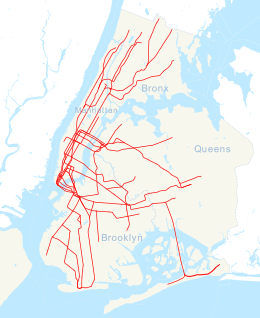Sutter Avenue (BMT Canarsie Line)
| Sutter Avenue | |||||||
|---|---|---|---|---|---|---|---|
| New York City Subway rapid transit station | |||||||
|
Station house | |||||||
| Station statistics | |||||||
| Address |
Sutter Avenue & Van Sinderen Avenue Brooklyn, NY 11207 | ||||||
| Borough | Brooklyn | ||||||
| Locale | Brownsville, East New York | ||||||
| Coordinates | 40°40′06″N 73°54′06″W / 40.668367°N 73.901768°WCoordinates: 40°40′06″N 73°54′06″W / 40.668367°N 73.901768°W | ||||||
| Division | B (BMT) | ||||||
| Line | BMT Canarsie Line | ||||||
| Services |
L | ||||||
| Transit connections |
| ||||||
| Structure | Elevated | ||||||
| Platforms | 2 side platforms | ||||||
| Tracks | 2 | ||||||
| Other information | |||||||
| Opened | December 28, 1906 | ||||||
| Traffic | |||||||
| Passengers (2015) |
1,453,567[1] | ||||||
| Rank | 314 out of 422 | ||||||
| Station succession | |||||||
| Next north |
Atlantic Avenue: L | ||||||
| Next south |
Livonia Avenue: L | ||||||
| |||||||
| |||||||
Sutter Avenue is a station on the BMT Canarsie Line of the New York City Subway. Located at the intersection of Van Sinderen and Sutter Avenues at the border of Brownsville and East New York, Brooklyn,[2] it is served by the L train at all times.[3]
Station layout
| P Platform level |
Side platform, doors will open on the right | |
| Westbound | ← | |
| Eastbound | → | |
| Side platform, doors will open on the right | ||
| M | Mezzanine | Fare control, station agent, MetroCard vending machines |
| G | Street Level | Exit/ Entrance |
This elevated station, opened on December 28, 1906, has two tracks and two side platforms.[4] The only entrance is via a ground level station house underneath the tracks on the northwest corner of Sutter and Van Sinderen Avenues.[2] Inside is a token booth, turnstile bank, and a single canopied staircase to each platform at their extreme south ends. The station is a microcosm of early-20th century BRT construction. Ornate period ironwork adorns the quaint wooden crosswalk beneath the south end of the station.
This station was renovated in 2006, which included new windscreens (beige with green frames) and canopies (red with green frames) that run along the entire length of the platforms except for a small section at the north end and installation of yellow tactile warning strips on the edges. Artwork called The Habitat for the Yellow Bird by Takayo Noda was also installed and features stained glass windows of flowers on the windscreens.[5][6]
Structure changes north of the station
North of this station, the Canarsie Line formerly split into two separate elevated structures, one above Van Sinderen Avenue and another a block east above Snediker Avenue via an "S" curve. This curve into was one of the sharpest in the subway at around 75 degrees. As the curve swung eastward, it passed under the last remnant of the Fulton Street Elevated. The tracks on this line curved east on their way to City Line, Brooklyn before ending at Pitkin Avenue. The two Canarsie elevated structures ran north into separate platforms at Atlantic Avenue.
After the Fulton Street Elevated was closed in 1956,[7] the Canarsie Line continued using the tracks it always had and the rest of the structure fell into disuse. In 2002–2004, the portion above Snediker Avenue was abandoned and the northbound Canarsie Line track was re-routed to share the western-most island platform with southbound Canarsie Line service there. Demolition of the unused elevated structure began in 2003 and was completed in 2005. Now, northbound L trains have a much gentler curve to the west, speeding service.
References
- ↑ "Facts and Figures: Annual Subway Ridership". Metropolitan Transportation Authority. Retrieved 2016-04-19.
- 1 2 "Neighborhood Map Brownsville Ocean Hill East New York Remsen Village" (PDF). mta.info. Metropolitan Transportation Authority. 2015. Retrieved October 2, 2016.
- ↑ "L Subway Timetable, Effective November 7, 2016" (PDF). New York Metropolitan Transportation Authority. Retrieved November 7, 2016.
- ↑ Marrero, Robert (2015-09-13). "469 Stations, 846 Miles" (PDF). B24 Blog, via Dropbox. Retrieved 2015-10-09.
- ↑ "www.nycsubway.org: Artwork: The Habitat for the Yellow Bird (Takayo Noda)". www.nycsubway.org. Retrieved 2016-10-02.
- ↑ "MTA - Arts & Design | NYCT Permanent Art". web.mta.info. Retrieved 2016-10-02.
- ↑ "First Leg of Rockaways Transit Opened at Cost of $10,154,702". nytimes.com. The New York Times. April 30, 1956. Retrieved 29 June 2015.
External links
- nycsubway.org – BMT Canarsie Line: Sutter Avenue
- Station Reporter — L Train
- The Subway Nut — Sutter Avenue Pictures
- MTA's Arts For Transit — Sutter Avenue (BMT Canarsie Line)
- Sutter Avenue entrance from Google Maps Street View



